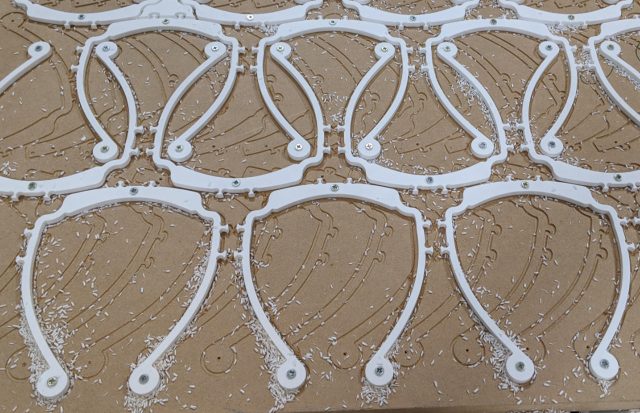
When the push to make face shields started we saw a lot of makerspaces and individuals fire up the 3D printers as tons of designs started showing up online. If you’ve got a 3D printer, by all means, help out by making things… they aren’t the fastest method, but they are nice in that it’s “hit print and walk away” to some degree. And filament? There are a lot of rolls of filament available. (Got access to 10 or 20 or 50 machines in a print farm? Get them running!)
We then saw other people start using laser cutters, which tend to be a lot faster than 3D printers, and PETG was the material of choice, until it ran out. We know a guy who used all the PETG he could source locally, then drove 16 hours to buy more, and at this point there are people who just cannot buy PETG to feed into their laser cutters. (If you can find PETG, keep going, fire those lasers!)
So we opted to use 1/4″ sheets of HDPE (high-density polyethylene) as our visor material. It machines really well and on a large CNC they go pretty fast. You might be familiar with HDPE if you own a plastic cutting board. It’s great because it can be easily cleaned and disinfected, unlike things that are 3D printed.
We’ve got two CNC machines running at a shop one of our members runs. (Milwaukee Makerspace is not open, we are not using the CNC machines there.) We are running with very few people, working a safe distance from each other. The process involves two replaceable spoilboards so you can prep one by screwing down the material, loading it onto the CNC and running it while you spend time unscrewing the cut material from the other one.
The other part of the face shield is the front part, the shield that is in front of your face. Clear semi-rigid vinyl was available so we got that. It cannot be laser cut (well, sort of) so we looked into getting a steel rule die made so we could cut them easily and quickly. In our quest to get a die made we talked to KAPCO Metal Stamping and they offered to just stamp them out for us. Amazing! We don’t have a clicker press and while some friends offered use of their equipment for automated loading and cutting, KAPCO can do a huge volume quickly and safely.
As long as the supply of HDPE and clear vinyl holds out, we’ll keep going with this process. If we can’t source those materials we’ll move on to something else. It’s probably a good idea to start making a list of other materials that could work, or alternative processes for making.